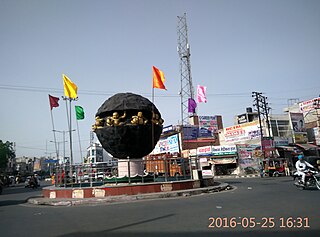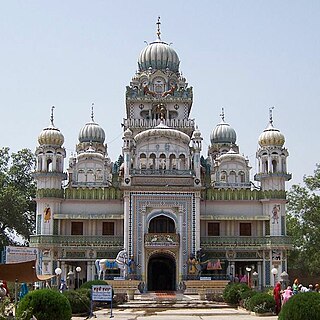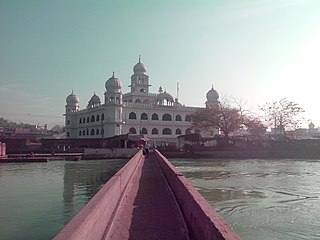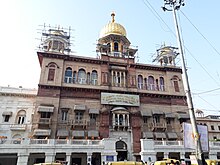
Guru Tegh Bahadur was the ninth of ten gurus who founded the Sikh religion and was the leader of Sikhs from 1665 until his beheading in 1675. He was born in Amritsar, Punjab, India in 1621 and was the youngest son of Guru Hargobind, the sixth Sikh guru. Considered a principled and fearless warrior, he was a learned spiritual scholar and a poet whose 115 hymns are included in the Guru Granth Sahib, which is the main text of Sikhism.
The following outline is provides an overview of Sikhism, or Sikhi.
The Chandni Chowk is one of the oldest and busiest markets in Old Delhi, India. It is located close to the Old Delhi Railway Station. The Red Fort monument is located at the eastern end of Chandni Chowk. It was built in the 17th century by the Mughal Emperor, Shah Jahan, and designed by his daughter, Jahanara. The market was once divided by canals to reflect moonlight. It remains one of India's largest wholesale markets.

Old Delhi is an area in the Central Delhi district of Delhi, India. It was founded as a walled city and officially named Shahjahanabad in 1648, when Shah Jahan decided to shift the Mughal capital from Agra. The construction of the city was completed in 1648, and it remained the capital of Mughal India until its fall in 1857, when the British Empire took over as paramount power in the Indian subcontinent.

Kaithal is a city and municipal council in the Kaithal district of the Indian state of Haryana. Kaithal was previously a part of Karnal district and later, Kurukshetra district until 1 November 1989, when it became the headquarters of the Kaithal. It shares a border with the Patiala district of state Punjab and the Kurukshetra, Jind and Karnal districts of Haryana. Kaithal district is situated in the North-West of the Haryana state. Its North-West boundaries, which include Guhla-Cheeka are attached to Punjab.

Anandpur Sahib, also referred simply as Anandpur, is a city in Rupnagar district (Ropar), on the edge of Shivalik Hills, in the Indian state of Punjab. Located near the Sutlej River, the city is one of the most sacred religious places in Sikhism, being the place where the last two Sikh Gurus, Guru Tegh Bahadur and Guru Gobind Singh, lived. It is also the place where Guru Gobind Singh founded the Khalsa Panth in 1699. The city is home to Takhat Sri Kesgarh Sahib, the third of the five Takhts in Sikhism.

The Gurdwara Rakab Ganj Sahib is a historic gurdwara near Parliament House in New Delhi. It was built in 1783, after Sikh military leader Baghel Singh (1730–1802) captured Delhi, on 11 March 1783, and his brief stay in Delhi, led to the construction of several Sikh religious shrines within the city. This one marks the site of cremation of the ninth Sikh Guru, Guru Tegh Bahadur, after his martyrdom in November 1675 for helping Kashmiri Hindu Pandits, under orders of the Islamic Mughal Emperor Aurangzeb. The Gurudwara Sahib is built near old Raisina village near Raisina Hill, at present Pandit Pant Marg, took 12 years to build. Prior to that, a mosque had been built near the spot.

Bhai Dayala, also known as Bhai Dayal Das, was an early martyr of Sikhism. He was boiled alongside his Sikh companions Bhai Mati Das and Bhai Sati Das and the Ninth Guru, Guru Tegh Bahadur.

Bhai Mati Das, along with his younger brother Bhai Sati Das were martyrs of early Sikh history. Bhai Mati Das, Bhai Dayala, and Bhai Sati Das were executed at a kotwali (police-station) in the Chandni Chowk area of Delhi, under the express orders of Emperor Aurangzeb just before the martyrdom of Guru Tegh Bahadur. Bhai Mati Das was executed by being bound between two pillars and cut in two.

Baghel Singh was a Military general in the Punjab region in the northern part of the Indian subcontinent in the 18th century. He rose to prominence in the area around Sutlej and Yamuna. He joined the Singh Krora Misl, one of the misls during Sikh Confederacy. In 1765, Singh became the leader of the misl.

Bhai Sati Das along with his elder brother Bhai Mati Das were martyrs of early Sikh history. Bhai Sati Das, Bhai Mati Das and Bhai Dyal Das were all executed at kotwali (police-station) in the Chandni Chowk area of Delhi, under the express orders of emperor Aurangzeb just prior to the martyrdom of Guru Tegh Bahadur. Bhai Sati Das was executed by the means of being wrapped in cotton wool soaked in oil and set on fire.

The Delhi Sikh Gurdwara Management Committee (DSGMC) is organization in India responsible for the management of Gurdwaras, Sikh places of worship in Delhi. It also manages various educational institutions, hospitals, old age homes, libraries and other charitable institutions in Delhi. It is headquartered in Gurdwara Rakab Ganj Sahib, near Parliament House. Currently, the president of DSGMC is Harmeet Singh Kalka.

Gurdwara Mehdiana Sahib, also called the 'School of Sikh History' is a Sikh gurdwara located in the village of Mehdiana, just outside Mallha, near Jagraon in Ludhiana district, India.
Martyrdom is a fundamental institution of Sikhism. Sikh festivals are largely focused on the lives of the Sikh gurus and Sikh martyrs. Their martyrdoms are regarded as instructional ideals for Sikhs, and have greatly influenced Sikh culture and practices.

Baba Jiwan Singh was a Sikh general and companion of Guru Gobind Singh.

Kiratpur, also known as Kiratpur Sahib, is a town, just 30 km from Rupnagar city in Rupnagar district of Punjab, India. The town is the location of the Gurdwara Patal Puri where many Sikhs take ashes of their deceased.
Gaggomahal or Gaggo Mahal is a village close to Teh Ajnala in the district of Amritsar, Punjab, India. Gaggomahal is a village of the Mahal caste.
Sikh attacks on Delhi were common in the second half of the 18th century. The Sikhs attacked Delhi 19 times between 1766 and 1788.


















